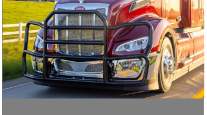Opinion: Safety Programs Help Protect Fleets, Drivers
According to The National Safety Council, vehicle accidents are among the most costly of injury claims for businesses. The average cost of a loss related to a vehicle accident is nearly twice as much as the average workplace injury.

Oates
For fleets, a comprehensive commercial safety program can mitigate risk and improve driver safety. But only if several guidelines are followed:
Policies and Procedures Must Be Written
Most fleets have safety policies and procedures, but they’re not written down nor enforced. A written set of policies and procedures — that is visible throughout the workplace — ensures consistency and that employees know what is expected of them. These policies also should make clear that the company is creating these policies to protect everyone and that leadership backs the policies.
A great way to secure employee buy-in is to offer incentives for following the policies and apply consequences for breaking the rules.
In one example, a fleet with more than 650 vehicles and employees driving 1.5 million miles per month established a corporate program to increase seat belt use among company drivers. When the program began, 74% of drivers were wearing seat belts; within two years, that rate was up to 94%. The company also experienced a 30% decrease in motor vehicle crashes.
In fact, seat belt use is one of the basics any safety program should include. Other standard polices that should be spelled out for employees include prohibitions on alcohol and drug use, guidelines for usage of mobile devices and instructions for vehicle inspection checklists.
Motor Vehicle Record Check and Driver Training
An important part of fleet safety is hiring safe drivers, and a driver’s record can reveal indicators of potential future performance. So it’s important that you pull that record for each one. A poor driving record can point to a higher likelihood of an accident in the future.
Many companies do the initial MVR check and assume their job is done, but if they’re not reviewing MVRs annually or more often, they’re open to risk.
It’s also important to define which violations require disciplinary measures and which do not. For example, what if a historically safe driver gets a minor violation? What happens if it is a moving violation? Thinking through the possibilities and defining processes will help companies stay consistent with policy enforcement.
One of the best ways to improve driver safety is through a driver-training program. Beyond standard training at hiring time, continued education on a semiannual basis keeps drivers fresh, informed and more aware. The training can include different elements, including videos, quizzes, webinars and in-person training. And it must be mandatory; companies must stipulate that drivers cannot drive without completing the training.
Driver Agreements and Driver Discipline
Once drivers have completed initial training, they must sign an agreement stating that they understand the company’s policies and everything that was covered in training. But make clear that drivers are free to raise questions and that the policies are designed to protect them and all company employees.
The driver agreement should include a vehicle inspection requirement, with a specific process they must follow. A process also should be in place for road violation reporting so drivers know exactly what to do should the need arise.
For incidents when a driver does not adhere to the policies, standards for disciplinary measures must be in place. These disciplinary measures can include reduced driving privileges for a first offense, removal of driving privileges for a second offense and employment termination for a third offense.
Formalizing a plan for vehicle inspection, repair and maintenance also can help reduce breakdowns and limit the potential for faulty equipment to contribute to an accident. When technicians conduct inspections, ensure that they provide written documentation of their findings. Personal vehicles also should be included in inspection and maintenance plans, but can have more lenient requirements
Development of an effective safety program is an investment in a company’s fleet and its employees, saving them money in operational, personnel, insurance and accident costs.
Nick Oates holds the designation of Certified Work Comp Advisor (CWCA). Based in Worcester, Mass., Knight-Dik Insurance provides risk-management solutions across all industries.




